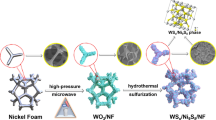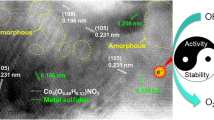Abstract
The ethylene glycol (EG)-mediated sol–gel method was applied to prepare Ni nanoparticles (NPs) where heating treatments of the dried precursors were performed in N2 protecting atmosphere. X-ray diffraction (XRD) analysis was conducted to determine the crystalline phases of the calcinated products. The diffraction peaks of the products being calcinated at 350 °C shifted to lower angles when the initial molar ratio of Ni2+:EG was decreased in the absence of urea, indicating that the crystalline phase of the product calcinated at 350 °C was Ni3C rather than hexagonal-close-packed (hcp) Ni. The Ni3C particles displayed a weak ferromagnetic character at room temperature and the Ni3C phase transformed to face-centered-cubic (fcc) nickel when the heating treatments were performed at 450 °C and higher temperatures. By using urea as an N source, the fcc Ni/N-doped carbon materials could be obtained in the range of 350–600 °C, and the as-prepared fcc Ni/N-doped carbon materials could be used as a catalyst toward the hydrogenation reduction reaction of 4-nitrophenol and an activity parameter of 74.56 s−1 g−1 was obtained. Our results provide a new insight into the differentiation of Ni3C and hcp Ni, and the catalytic behavior of Ni NPs.

Nickel/N-doped carbon nanomaterials being calcinated at 350–600 °C by using ethylene glycol mediated sol–gel process have excellent catalytic properties toward hydrogenation reaction of 4-nitrophenol.
Highlights
-
Nickel nanoparticles could be prepared by the ethylene glycol (EG)-mediated sol–gel method.
-
Ni3C rather than the hexagonal-close-packed Ni phase was confirmed in products being calcined at 350 °C.
-
As-prepared nanomaterial could be used as a catalyst for hydrogenation reaction of 4-nitrophenol.
-
Excellent catalytic behavior of Ni/N-doped carbon material occurs by using urea as N source.














Similar content being viewed by others
References
LaGrow AP, Cheong S, Watt J, Ingham B, Toney MF, Jefferson DA, Tilley RD (2013) Can polymorphism be used to form branched metal nanostructures? Adv Mater 25:1552–1556
Nie RF, Yang HH, Zhang HF, Yu XL, Lu XH, Zhou D, Xia QH (2017) Mild-temperature hydrodeoxygenation of vanillin over porous nitrogen-doped carbon black supported nickel nanoparticles. Green Chem 19:3126–3134
LaGrow AP, Ingham B, Cheong S, Williams GVM, Dotzler C, Toney MF, Jefferson DA, Corbos EC, Bishop PT, Cookson J, Tilley RD (2012) Synthesis, alignment, and magnetic properties of monodisperse nickel nanocubes. J Am Chem Soc 134:855–858
Xia JW, He GY, Zhang LL, Sun XQ, Wang X (2016) Hydrogenation of nitrophenols catalyzed by carbon black-supported nickel nanoparticles under mild conditions. Appl Catal B Environ 180:408–415
He L (2010) Hexagonal close-packed nickel or Ni3C? J Magn Magn Mater 322:1991–1993
Tian CS, Qian D, Wu D, He RH, Wu YZ, Tang WX, Yin LF, Shi YS, Dong GS, Jin XF, Jiang XM, Liu FQ, Qian HJ, Sun K, Wang LM, Rossi G, Qiu ZQ, Shi J (2005) Body-centered-cubic nickel and its magnetic properties. Phys Rev Lett 94:137210
Jeon YT, Moon JY, Lee GH, Park J, Chang YM (2006) Comparison of the magnetic properties of metastable hexagonal close-packed Ni nanoparticles with those of stable face-centered-cubic Ni nanoparticles. J Phys Chem B 110:1187–1191
Schaefer ZL, Weeber KM, Misra R, Schiffer P, Schaak RE (2011) Bridging hcp-Ni and Ni3C via a Ni3C1-x solid solution: tunable composition and magnetism in colloidal nickel carbide nanoparticles. Chem Mater 23:2475–2480
Li PY, Zhang P, Li FS, Jiang W, Cao ZH (2013) Pure face-centered-cubic (fcc) and hexagonal-close-packed (hcp) nickel phases obtained in air atmosphere sol–gel process and fcc nickel phase obtained in N2 protected sol–gel process. J Sol-Gel Sci Technol 68:261–269
Zhang P, Li PY, Li FS, Jiang W, Cao ZH (2014) Lactic acid based sol–gel process of Ag nanoparticles and crystalline phase control of Ni particles in aqueous sol–gel process. J Sol-Gel Sci Technol 72:398–404
Li PY, Li FS, Deng GD, Guo XD, Liu HY, Jiang W, Wang TH (2016) Polymerized-complex method for preparation of supported bimetallic alloy and monometallic nanoparticles. Chem Commun 52:2996–2999
Li PY, Wang QQ, Deng GD, Guo XD, Jiang W, Liu HY, Li FS, Thanh NTK (2017) A new insight into the thermodynamical criterion for the preparation of semiconductor and metal nanocrystals using a polymerized complexing method. Phys Chem Chem Phys 19:24742–24751
He X, Kong LT, Liu BX (2005) Calculation of ferromagnetic states in metastable bcc and hcp Ni by projector-augmented wave method. J Appl Phys 97:106107
JCPDS: 04-0853
Lu HM, Zheng WT, Jiang Q (2007) Saturation of magnetization of ferromagnetic and ferrimagnetic nanocrystals at room temperature. J Phys D Appl Phys 40:320–325
Zhong WH, Sun CQ (2004) Size effect on the magnetism of nanocrystalline Ni films at ambient temperature. Solid State Commun 130:603–606
Li PY, Jiang W, Li FS (2013) Non-aqueous sol–gel preparation of carbon-supported nickel nanoparticles. J Sol-Gel Sci Technol 65:359–366
Tian F, Tian H, Whitmore L, Ye LY (2015) Magnetism of hexagonal close-packed nickel calculated by full-potential linearized augmented plane wave method. J Magn Magn Mater 384:49–51
Yue LP, Sabiryanov R, Kirkpatrick EM, Lesile-Pelecky DL (2000) Magnetic properties of disordered Ni3C. Phys Rev B 62:8969–8975
Goto Y, Taniguchi K, Omata T, Otsuka-Yao-Matsuo S, Ohashi N, Ueda S, Yoshikawa Y, Oohashi H, Kobayashi K (2008) Formation of Ni3C nanocrystals by thermolysis of nickel acetylacetonate in oleylamine: characterization using hard x-ray photoelectron spectroscopy. Chem Mater 20:4156–4160
Chen CP, He L, Leng YH, Li XG (2009) Weak ferromagnetism and spin-glass state with nanosized nickel carbide. J Appl Phys 105:123923
Zhang YJ, Zhu Y, Cao Y, Li D, Zhang ZD, Wang KJ, Ding F, Wang XL, Meng D, Fan LH, Wu J (2016) Size and morphology-controlled synthesis of Ni3C nanoparticles in a TEG solution and their magnetic properties. RSC Adv 6:81989–81994
Xu Y, Tu WG, Zhang BW, Yin SM, Huang YZ, Kraft M, Xu R (2017) Nickel nanoparticles encapsulated in few-layer nitrogen doped graphene derived from metal–organic frameworks as effcient bifunctional electrocatalysts for overall water splitting. Adv Mater 29:1605957
Yao WT, Yu L, Yao PF, Wei K, Han SL, Chen P, Xie JS (2016) Bulk production of nonprecious metal catalysts from cheap starch as precursor and their excellent electrochemical activity. ACS Sustainable Chem Eng 4:3235–3244
Yang Y, Ren Y, Sun CJ, Hao SJ (2014) Facile route fabrication of nickel based mesoporous carbons with high catalytic performance towards 4-nitrophenol reduction. Green Chem 16:2273–2280
Liu XY, Xu D, Wang Q, Zhang L (2018) Fabrication of 3D hierarchical byttneria aspera-like Ni@Graphitic carbon yolk-shell microspheres as bifunctional catalysts for ultraefficient oxidation/reduction of organic contaminants. Small 14:1803188
Xu D, Zhang DL, Zou HB, Zhu LK, Xue M, Fang QR, Qiu SL (2016) Guidance from an in-situ hot stage in TEM to synthesize magnetic metal nanoparticles from a MOF. Chem Commun 52:10513–10516
Hu CG, Dai LM (2019) Doping of carbon materials for metal-free electrocatalysis. Adv Mater 31:1804672
Wang D, Astruc D (2017) The recent development of efficient earth-abundant transition-metal nanocatalysts. Chem Soc Rev 46:816–854
Aditya T, Pal A, Pal T (2015) Nitroarene reduction: a trusted model reaction to test nanoparticles catalysts. Chem Commun 51:9410–9431
Lv WJ, Ju YY, Chen YL, Chen XG (2018) In situ synthesis of gold nanoparticles on N-doped graphene quantum dots for highly efficient catalytic degradation of nitrophenol. Int J Hydrogen Energy 43:10334–10340
Jiang ZF, Xie JM, Jiang DL, Wei XJ, Chen M (2013) Modifiers-assisted formation of nickel nanoparticles and their catalytic application to p-nitrophenol reduction. CrystEngComm 15:560–569
Wu JW, Liu W, Xiang X, Sun K, Liu FH, Cai C, Han SB, Xie YY, Li S, Zu XT (2017) From Ni(OH)2/Graphene composite to Ni@Graphene core-shell: a self-catalyzed epitaxial growth and enhanced activity for nitrophenol reduction. Carbon 117:192–200
Wu YG, Wen M, Wu QS, Fang H (2014) Ni/graphene nanostructure and its electron-enhanced catalytic action for hydrogenation reaction of nitrophenol. J Phys Chem C 118:6307–6313
Cao YL, Mao SJ, Li MM, Chen YQ, Wang Y (2017) Metal/porous carbon composites for heterogeneous catalysis: old catalysts with improved performance promoted by N-doping. ACS Catal 7:8090–8112
Formenti D, Ferretti F, Scharnagl FK, Beller M (2019) Reduction of nitro compounds using 3d-non-noble metal catalysts. Chem Rev 119:2611–2680
Xiang HJ, Huang B, Li ZY, Wei SH, Yang JL, Gong XG (2012) Ordered semiconducting nitrogen-graphene alloys. Phys Rev X 2:011003
Li XH, Antonietti M (2013) Metal nanoparticles at mesoporous N-doped carbons and carbon nitrides: functional Mott-Schottky heterojunctions for catalysis. Chem Soc Rev 42:6593–6604
Danks AE, Hall SR, Schnepp Z (2016) The evolution of ′sol-gel′ chemistry as a technique for materials synthesis. Mater Horiz 3:91–112
Rodrigues CSD, Soares OSGP, Pinho MT, Pereira MFR, Madeira LM (2017) P-Nitrophenol degradation by heterogeneous fenton’s oxidation over activated carbon-based catalysts. Appl Catal B Environ 219:109–122
Wei ZZ, Wang J, Mao SJ, Su DF, Jin HY, Wang YH, Xu F, Li HR, Wang Y (2015) In-situ generated Co-0-Co3O4/N-doped carbon nanotubes hybrids as efficient and chemoselective catalysts for hydrogenation of nitroarenes. ACS Catal 5:4783–4789
Acknowledgements
This work was jointly supported by the National Natural Science Foundation of China Youth Fund (51201090), Project Funded by the Priority Academic Program Development of Jiangsu Higher Education Institutions (PAPD).
Author information
Authors and Affiliations
Corresponding author
Ethics declarations
Conflict of interest
The authors declare that they have no conflict of interest.
Additional information
Publisher’s note: Springer Nature remains neutral with regard to jurisdictional claims in published maps and institutional affiliations.
Rights and permissions
About this article
Cite this article
Wang, J., Jiang, S., Li, P. et al. Differentiation of Ni3C crystalline phase from hexagonal-close-packed Ni phase in ethylene glycol-mediated sol–gel process and excellent catalytic behavior of Ni/N-doped C nanomaterials toward hydrogenation reduction reaction of 4-nitrophenol. J Sol-Gel Sci Technol 93, 341–353 (2020). https://doi.org/10.1007/s10971-019-05104-1
Received:
Accepted:
Published:
Issue Date:
DOI: https://doi.org/10.1007/s10971-019-05104-1




